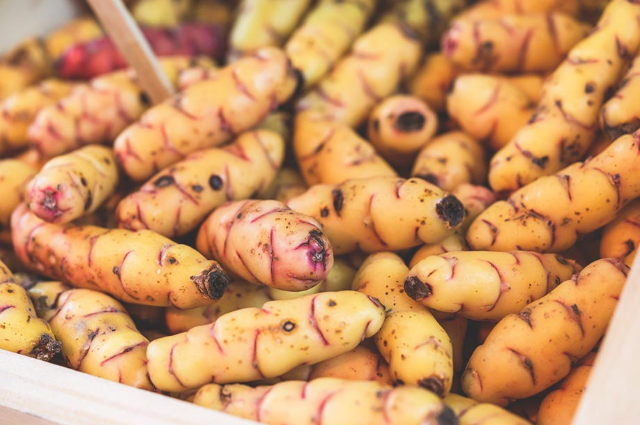
When we think of vegetables, we think of potatoes, onions, tomatoes, carrots, cabbage, cauliflowers, spinach, radishes, and… well, the list is never-ending. But far away beyond our realities, in the depths of remote valleys, amidst the ancient forests and along the coastal towns, lie many edible plants so rare, most of us have neither heard their names nor seen them, let alone tasted them! They aren’t just unique in appearance and taste but carry with them a long history of royalty and cultural heritage that faded away with the storms of time. Today’s article explores six of the world’s rarest vegetables, uncovering their history and why they deserve a place not just on our plate but also in the story of our shared food heritage!
Oca: The Jewel of the Andes
Oca (Oxalis tuberosa) is a native vegetable of the Andes mountains in South America. It has been used as an alternative to potatoes for more than 1,000 years. Its vibrant appearance, from the sunny yellow tinge to dark purple, makes it visually appealing. It is lemon-flavoured when raw and has a sweet taste when ripe. Another fact that makes it special is that it grows without the need for pesticides, making it eco-friendly and resilient. In fact, one reason why people grew it was to maintain the quality of the soil. It is also seen as a symbol of resilience since it can grow in poor soil and harsh climates and is celebrated in Andean festivals. The leaves of this vegetable are also used in salads. Ocas can be boiled, roasted, fried, or even eaten raw! Talk about versatility!
Fiddlehead Ferns: Spring’s Secret Love
Fiddlehead ferns (Matteuccia struthiopteris) get their names thanks to their spiral shape, like the scroll of a violin. They have been in existence for 100 million years, even before the dinosaurs! Their presence for just a few weeks during spring makes them a rare and exotic dish that has been celebrated for centuries. It has different names across the world, like warabi in Japan, gosari in Korea, lingad in India, and so on. These ferns grow near rivers and in forested areas, making them difficult to cultivate. But its rarity can be justified by the fact that it is a superfood rich in vitamins A and C, iron, potassium, and omega-3 fatty acids! However, they must be boiled well to remove any natural toxins.
Sea Kale: The Forgotten Treasure of Coastal Europe
Sea kale (Crambe maritima) thrives on the coastlines of Western Europe. It was a royal dish in Victorian England and France, grown in seaside gardens before fading into obscurity due to its short shelf life and difficult cultivation. It is rich in vitamin C and was even shipped to different places to treat scurvy. Its bluish-green leaves, fragrant white flowers, and nutty-tasting shoots are all edible. Its speciality is its mix of sweet, nutty, and slightly bitter.
Kullu Beans: India’s Hidden Protein
Kullu beans (Macrotyloma uniflorum) are a rare kind of legume native to the Kullu Valley in Himachal Pradesh, India. They are grown and valued for their hardiness, nutritional value, and medicinal uses. Kullu beans have been found to have been grown since 2500 BCE, as found in archaeological remains. They are used in winter stews, ritual offerings, and as ayurvedic remedies. Truly, a multi-use vegetable! Kullu beans are rich in iron, protein, fibre, and polyphenols, thereby helping with digestion, diabetes, and high cholesterol. Kullu beans are soaked and slow-cooked to soften their hard texture. In Himachal, they’re used in dishes like Kulitan Saaru (a soup), Ghassi (a coconut-based curry), and Upkari (a dry stir-fry). Sadly, despite their nutritional and medicinal powers, Kullu beans aren’t cultivated anywhere else, making them a rare crop and symbol of Himalayan identity.
Celtuce: China’s Wonder
Celtuce (Lactuca sativa var. augustana), also known as stem lettuce or asparagus lettuce, is a unique vegetable, held in importance for its thick, crisp, and tasty stem. It has been cultivated in southern China for 1,500 years and derives its name from ‘celery’ and ‘lettuce’ due to its hybrid appearance and flavour. Known as wosun in China, it has cooling properties that are used to treat inflammation and digestive issues. It is also rich in vitamins A, C, and K, potassium, and fibre. It was originally introduced in the West as an ornamental plant before its culinary side was discovered. Celtuce can be fried, pickled, grilled, and even eaten raw. Another synonym for versatility! The leaves are tougher in texture but are also used in soups, gaining popularity in the West as a gluten-free pasta substitute.
Mashua: The Bloom of the Andes
Another exotic crop of the Andes, Mashua (Tropaeolum tuberosum), is known for its pepper flavour, colourful flowers, and medicinal history. It has been grown for over 5,000 years, with pictographs from that age showing it alongside potatoes and oca. Spanish records show that it was fed to armies to suppress libido, believing it reduced romantic distractions among the soldiers! Today, it is grown in South America, New Zealand, and the Pacific Northwest because of its ability to grow in harsh weather. Its uniqueness lies in its tubers, leaves, and flowers, all of which are edible. Its tubers can be boiled, roasted, or directly added to stews. Its flowers are used in salads, while its leaves are used like mustard greens. In some places, it is also used in deserts. Mashua is rich in anthocyanins and antioxidants and is used to treat kidney ailments, skin ulcers, and inflammation.
Conclusion
Rare vegetables are not just edible mysteries but living symbols of resilience, heritage, and ecological diversity. While there are more in the list, these six vegetables tell a tale spanning thousands of years in the remote corners of the world. As modern agriculture looks towards uniformity, these plants remind us of nature’s resilience. These rare and exotic vegetables deserve to be preserved, protected, and given equal rights to be on our plates!
